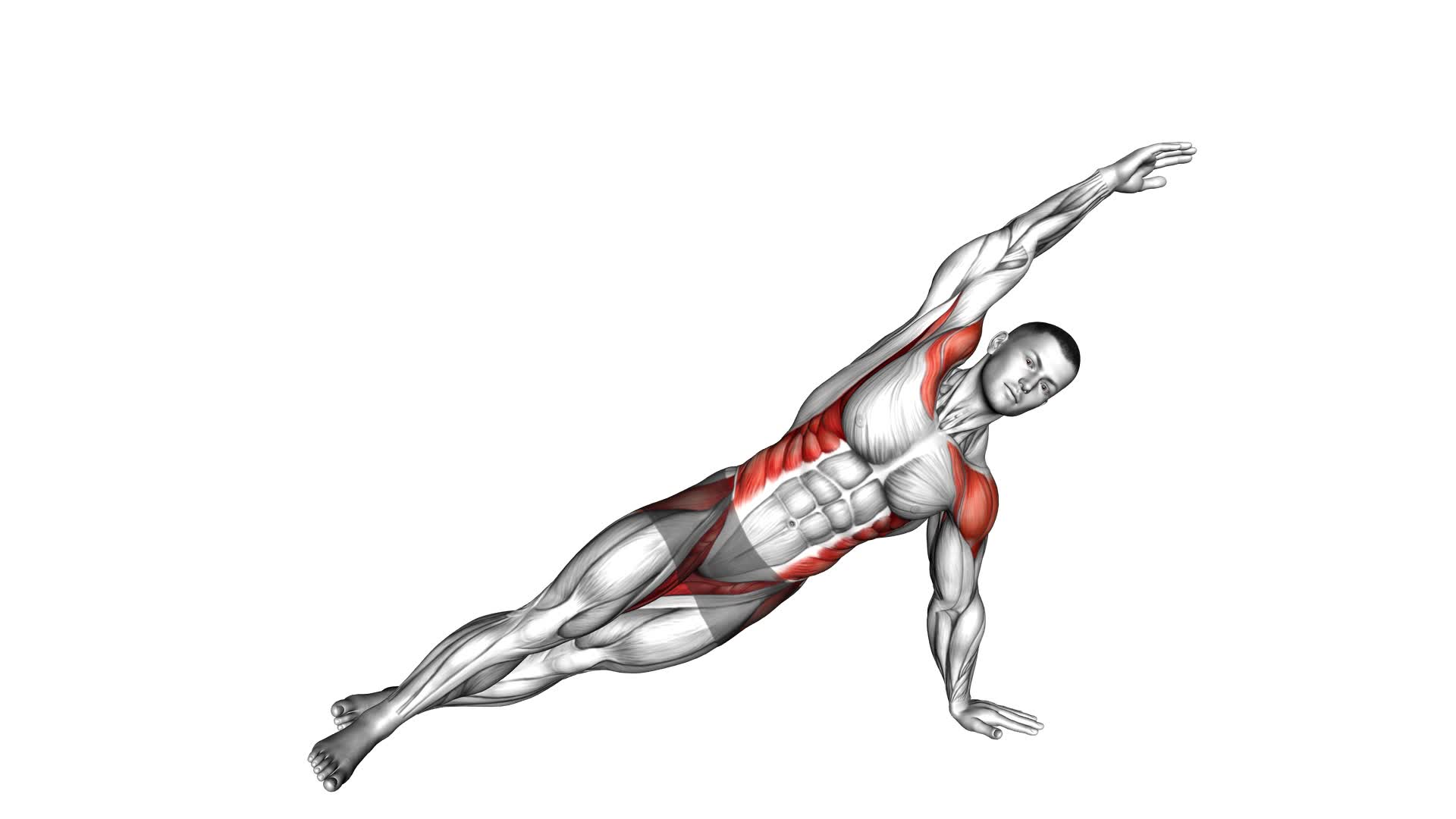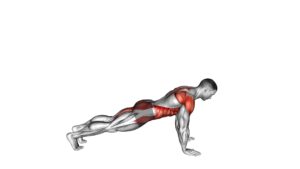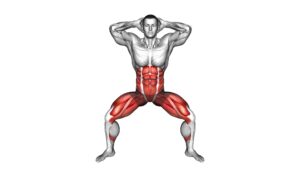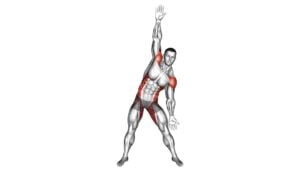Side Bend Plank (male) – Video Exercise Guide & Tips

Get ready to strengthen your core with the side bend plank! In this video exercise guide, we'll show you the proper form and technique for this challenging move. Whether you're a beginner or a seasoned fitness enthusiast, we've got modifications for all fitness levels.
Watch This Exercise Video
Plus, we'll share variations to spice up your workout and give you tips for maximizing your results.
So grab your mat and get ready to feel the burn!
Key Takeaways
- Side Bend Plank targets core stability and oblique strength.
- Proper form and technique include engaging the core, keeping hips lifted and aligned, maintaining a straight line from head to toe, and focusing on core activation techniques.
- Core engagement is important to avoid sagging or arching the lower back, and to maximize the benefits of a strong core.
- To avoid lower back strain, start in a high plank position, engage the core and squeeze glutes for stability, avoid letting the lower back sag or hips drop, and maintain proper form and alignment.
Benefits of Side Bend Plank
To maximize your core strength and stability, incorporate the side bend plank into your workout routine. This exercise targets your core stability and oblique strength, helping you develop a strong and toned midsection. The side bend plank primarily works the oblique muscles, which are located on the sides of your abdomen. By engaging these muscles, you can improve your posture, enhance your balance, and prevent lower back pain.
The side bend plank also activates other muscles in your body, including your transverse abdominis, rectus abdominis, and erector spinae. These muscles work together to provide stability and support to your spine. By strengthening them, you can reduce the risk of injuries and enhance your overall athletic performance.
In addition to the physical benefits, the side bend plank also challenges your mental focus and concentration. Holding the position requires mental endurance, as you need to maintain proper form and technique throughout the exercise. This mental engagement can help improve your mind-body connection and enhance your overall fitness experience.
In the next section, we'll discuss the proper form and technique for performing the side bend plank to ensure that you get the most out of this exercise and avoid any potential injuries.
Proper Form and Technique
To perform the Side Bend Plank with proper form and technique, it's important to engage your core throughout the exercise. This will help you maintain stability and control, while also targeting your obliques effectively.
Additionally, be mindful of avoiding lower back strain by keeping your hips lifted and aligned with your body, rather than sagging or dropping.
Core Engagement Importance
Engage your core properly by maintaining proper form and technique during the Side Bend Plank exercise. By focusing on core activation techniques, you can ensure that you're maximizing the benefits of a strong core. Here are some key points to keep in mind:
- Keep your body in a straight line from head to toe, with your core muscles engaged throughout the exercise.
- Avoid sagging or arching your lower back, as this can put strain on your spine.
- Squeeze your glutes and engage your abdominal muscles to stabilize your body and maintain proper alignment.
Avoiding Lower Back Strain
Maintain proper form and technique to avoid lower back strain during the Side Bend Plank exercise. This is crucial for preventing injury and maintaining proper alignment.
To avoid lower back strain, start by positioning yourself in a high plank position with your hands directly under your shoulders and your body in a straight line from head to toe. Engage your core muscles and squeeze your glutes to maintain stability.
As you lower onto your forearm, be careful not to let your lower back sag or your hips drop. Keep your abs engaged and your spine neutral throughout the exercise.
Common Mistakes to Avoid
Avoiding common mistakes is crucial for effective execution of the Side Bend Plank exercise. To ensure proper alignment and maximize the benefits of this exercise, pay attention to the following:
- Keep your body in a straight line from head to toe. Avoid arching or sagging your back, as this can strain your lower back and compromise the effectiveness of the exercise.
- Engage your core muscles throughout the movement. This will help stabilize your body and prevent excessive rotation or tilting.
- Remember to breathe properly. Inhale deeply through your nose as you prepare for the exercise, and exhale slowly through your mouth as you hold the plank position. This controlled breathing technique will help you maintain focus and stability.
By avoiding these common mistakes and maintaining proper alignment and breathing techniques, you can perform the Side Bend Plank exercise safely and effectively.
Now, let's move on to the next section and explore modifications for different fitness levels.
Modifications for Different Fitness Levels
To modify the Side Bend Plank exercise for different fitness levels, you can adjust the duration of the plank hold. For beginners or those with lower fitness levels, start with shorter holds, such as 10-15 seconds, and gradually increase the duration as you build strength and endurance. This allows your body to adapt to the exercise without overwhelming your muscles.
As you progress, aim to hold the side plank for 30 seconds or longer to further challenge your core stability.
In addition to adjusting the duration, you can also modify the exercise by performing it on your knees instead of your feet. This reduces the amount of body weight you have to support, making the exercise more manageable for beginners. As you become more proficient, gradually transition to the full side plank position to increase the intensity.
To continue challenging yourself and progress further, you can incorporate different exercises and progression techniques into your side plank routine. For example, you can add leg lifts or hip dips to engage your obliques and increase the difficulty of the exercise. Alternatively, you can try performing the side plank on an unstable surface, such as a Bosu ball or a foam pad, to further challenge your core stability.
With these modifications and progression techniques, you can tailor the Side Bend Plank exercise to your current fitness level and continue to challenge yourself as you get stronger.
Now, let's explore some variations to spice up your workout.
Variations to Spice Up Your Workout
Looking to add some excitement to your workout routine? Try incorporating resistance bands or stability balls into your side bend plank.
Resistance bands can provide an extra challenge by adding tension to your muscles, while stability balls engage your core and improve balance.
These variations won't only spice up your workout, but also help you achieve greater strength and stability.
Adding Resistance Bands
Enhance your workout with the addition of resistance bands. Resistance band exercises are a great way to spice up your workout routine while also improving balance and stability. Here are three variations to incorporate resistance bands into your workout:
- Banded Squats: Place a resistance band just above your knees and perform squats. The band adds resistance, targeting your glutes and hips, while also challenging your balance.
- Banded Push-Ups: Loop a resistance band around your back and hold the ends in your hands while performing push-ups. The band adds resistance, making your upper body work harder and improving stability.
- Banded Lateral Walks: Step into a resistance band and place it just above your ankles. Step sideways, maintaining tension in the band. This exercise targets your hips and glutes, while also challenging your balance and stability.
Incorporating Stability Balls
You can easily incorporate stability balls into your workout routine by frequently using them for added variation and intensity. Stability ball exercises are a great way to challenge your core muscles and improve balance and stability.
One simple stability ball workout is the stability ball plank, where you place your forearms on the ball and hold a plank position. This exercise engages your core muscles and helps strengthen your abs, back, and shoulders.
Another stability ball exercise is the stability ball squat, which adds an element of instability to your squat, making it more challenging and effective.
Tips for Maximizing Results
To maximize results, focus on maintaining proper form and engaging your core during the Side Bend Plank exercise. This won't only help you target the desired muscles effectively but also prevent any potential injuries.
Here are some tips to help you get the most out of your Side Bend Plank:
- Maximizing Intensity: To increase the intensity of the exercise, try lifting your top leg while holding the plank position. This will engage your obliques and add an extra challenge to the exercise.
- Increasing Duration: Start by holding the Side Bend Plank for 30 seconds, and gradually increase the duration as you get stronger. Aim for a goal of holding the plank for 60 seconds or longer to maximize the benefits.
- Focus on Breathing: It's important to maintain steady breathing throughout the exercise. Exhale as you lift your hips and engage your core, and inhale as you lower your hips back down. This will help you maintain stability and engage your core muscles more effectively.
Remember to listen to your body and take breaks when needed. Consistency is key when it comes to seeing results, so make sure to incorporate the Side Bend Plank into your regular workout routine.
Frequently Asked Questions
How Many Calories Can You Burn by Doing a Side Bend Plank?
When you do a side bend plank, you can burn calories and increase the effectiveness of your workout. This exercise targets your obliques, core, and other muscles, leading to a higher calorie burn.
The side bend plank engages multiple muscle groups, helping you build strength and stability while also torching calories. Incorporating this exercise into your routine can contribute to your overall calorie burning goals and help you achieve a toned and strong physique.
Can the Side Bend Plank Help in Reducing Love Handles?
The side bend plank is a great exercise for reducing love handles. By engaging your oblique muscles, it helps to strengthen and tone your sides. This exercise targets the love handle area and can help to reduce excess fat in that area over time.
There are also variations of the side bend plank that you can incorporate into your routine to add variety and challenge.
Is the Side Bend Plank Suitable for People With Lower Back Pain?
If you have lower back pain, the side bend plank may not be the best exercise for you. It can put strain on your lower back and potentially worsen your pain.
However, there are modifications you can make to the side bend plank to make it more suitable for beginners with lower back pain.
Alternatively, there are other exercises you can do that target the same muscle groups without putting as much stress on your lower back.
How Long Should One Hold the Side Bend Plank to See Noticeable Results?
To see noticeable results from the side bend plank, it's important to hold the position for an adequate amount of time. The duration can vary depending on your fitness level and goals.
Generally, aim for holding the side bend plank for at least 30 seconds to 1 minute. As you progress, you can increase the time or try different side bend plank variations to challenge your muscles.
Remember to maintain proper form throughout the exercise to maximize its effectiveness.
Can the Side Bend Plank Help in Improving Posture?
Yes, the side bend plank can definitely help in improving your posture.
By incorporating this exercise into your routine, you can strengthen your core muscles, which play a key role in maintaining proper posture.
Additionally, the side bend plank can also help increase flexibility in your spine and hips.
Conclusion
Incorporating side bend planks into your workout routine can provide numerous benefits, including improved core strength and stability.
By maintaining proper form and avoiding common mistakes, you can maximize the effectiveness of this exercise.
Additionally, modifying the side bend plank to suit different fitness levels and trying variations can keep your routine challenging and exciting.
Remember to follow these tips to achieve optimal results and enhance your overall fitness.

Author
Years ago, the spark of my life’s passion ignited in my mind the moment I stepped into the local gym for the first time. The inaugural bead of perspiration, the initial endeavor, the very first surge of endorphins, and a sense of pride that washed over me post-workout marked the beginning of my deep-seated interest in strength sports, fitness, and sports nutrition. This very curiosity blossomed rapidly into a profound fascination, propelling me to earn a Master’s degree in Physical Education from the Academy of Physical Education in Krakow, followed by a Sports Manager diploma from the Jagiellonian University. My journey of growth led me to gain more specialized qualifications, such as being a certified personal trainer with a focus on sports dietetics, a lifeguard, and an instructor for wellness and corrective gymnastics. Theoretical knowledge paired seamlessly with practical experience, reinforcing my belief that the transformation of individuals under my guidance was also a reflection of my personal growth. This belief holds true even today. Each day, I strive to push the boundaries and explore new realms. These realms gently elevate me to greater heights. The unique combination of passion for my field and the continuous quest for growth fuels my drive to break new ground.







